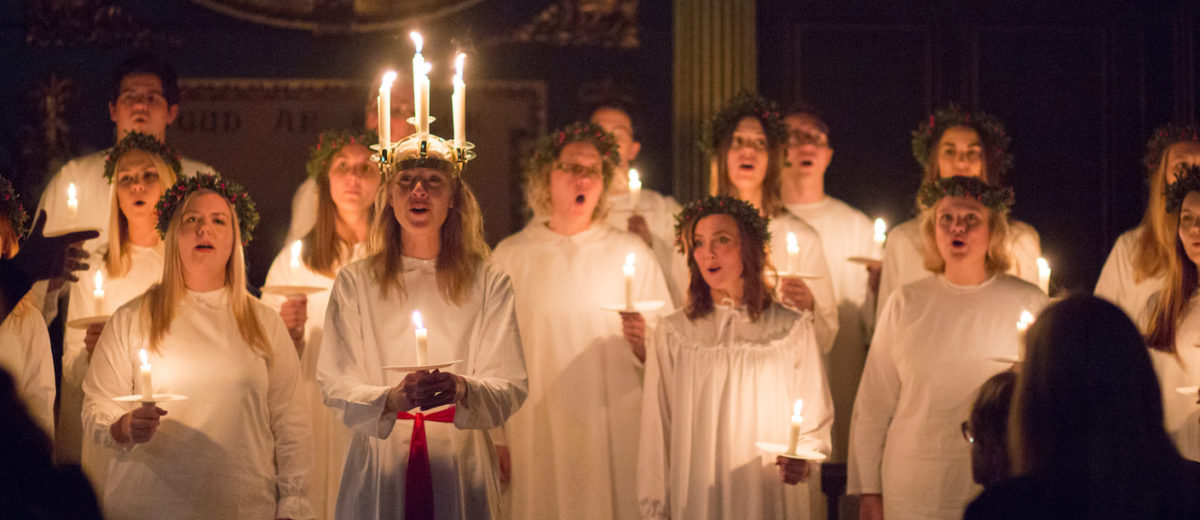While in Norway last week, I was reminded of the Scandinavian celebration of the Feast of Saint Lucy (Santa Lucia in Norway and Denmark, and Sankta Lucia in Sweden and Swedish-speaking Finland), on December 13.
This year that was last Thursday, when all across Scandinavia girls dressed in white with a red sash around their waists headed up processions in churches and halls, carefully carrying candle-lit wreaths on their heads.
I first became aware of this Nordic commemoration many years ago at Heidebeek when a Swedish girl named Emma-Karin walked through our halls as the day was just beginning, wearing this garland of candles. The closest association that comes to a Dutch mind is that of Vincent van Gogh trying to paint at night in the light of candles stuck to the brim of his hat, perhaps during his spells of mental instability.
But there’s nothing insane about the Scandinavian feast day. It is part of Advent, preparing for the arrival of the Light of Christ in the Christian calendar, on Christmas Day. In John’s words (as paraphrased by Eugene Peterson), ‘The Life-Light was the real thing: Every person entering Life he brings into Light.’ (MSG) John 1:9.
December 13 once coincided with the Winter Solstice, the longest night of the year before the current Gregorian Calendar was adopted in Scandinavia in the mid-18th century. The English poet, John Donne, who also served as dean of St Paul’s Cathedral in London wrote a poem about Saint Lucy’s day: ‘A Nocturnal upon S. Lucy’s Day, Being the Shortest Day’.
Martyr
So who was this Lucy, and why do the Scandinavians celebrate her feast? According to legend, Saint Lucy was martyred on December 13, in 304 AD during the persecution under Emperor Diocletian. (The red sash symbolises her martyrdom). She brought food and supplies to fellow Christians hiding in the catacombs of St John in Syracuse, and used a candle-lit wreath to light her way through the dark passages, leaving her hands free to carry as much as possible.
Sorting fact from fantasy is nigh impossible when the only source is a hagiography. Her story comes from the fifth-century Acts of the Martyrs, while Greek inscriptions from the catacombs of St. John in Syracuse provide the oldest archaeological evidence about her.
Lucy seems to have been born of rich and noble parents in Syracuse, Sicily, around 283. Her father was Roman but died when she was five years old. Lucy, or Lucia (Lux, Lucis – light) became a devout Christian and made a vow of virginity. Her mother arranged for her to be married, however, to a pagan.
Before the marriage took place, Lucy was praying for her mother’s illness at the shrine of Saint Agatha when, the story goes, the saint appeared to her in a dream, and told Lucy her mother would be healed. Lucy was able to convince her mother to cancel the wedding and donate the dowry to the poor.
Witness
Her proposed groom was enraged, and reported her to the governor for being a Christian. She was then threatened to be put in a brothel if she did not renounce her Christian beliefs. The legend related that not even a thousand men and fifty oxen pulling were able to move her. So they piled flammable materials around her and set light to it, but even then they could not stop the young woman from talking, zealous to die faithfully and strengthen other believers. Even when a soldier thrust a spear through her throat, her witness did not stop. Her eyes were gouged out, but they were miraculously restored, so the legend goes. Only after receiving Christian Last Rites was Saint Lucy able to die.
The Feast of Saint Lucy became a universal feast of the Church in the 6th century, and is also celebrated today in parts of Italy, Hungary and Croatia. Missionaries to the Scandinavians telling about St Lucy found their listeners responding enthusiastically to the story of a young girl bringing light into the darkness. It brought hope to the Viking peoples who had to endure long winter nights.
That is the Light we still celebrate this Advent.
In him was life, and that life was the light of all mankind. The light shines in the darkness, and the darkness has not put it out. John 1:4,5
Till next week,


